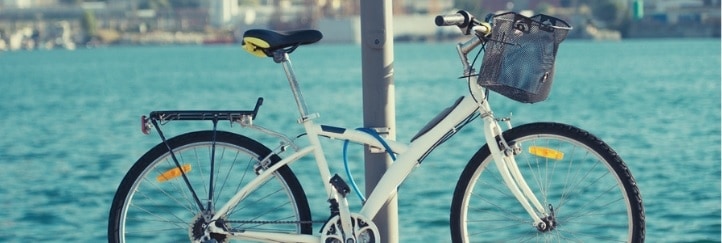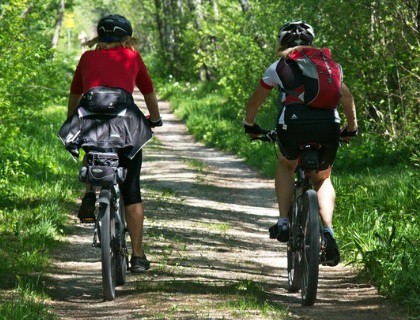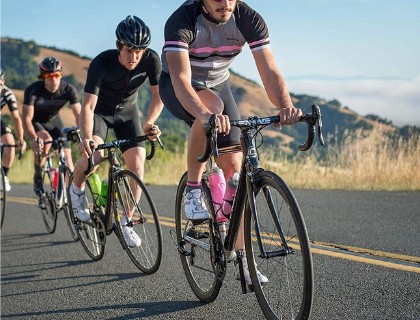Thankfully, there are now a lot of ways to travel economically, and a touring bike is great way to do that. Bike touring brings out the best way to relax and travel: by doing exercises that are good for your health. Today’s article is dedicated to all dreamers who want to know more about the best touring tires of 2018, but not before we get a glimpse of the general need-to-know information.
Table Of Contents
Top 5 Bike Tires for Touring Comparisons
Brand | Details |
|---|---|
 SCHWALBE Marathon Plus HS Wire Tire | |
 Continental Touring Plus Reflex Road Tire | |
 Vittoria Randonneur II City Tire | |
 Clement Cycling X'PLOR MSO Clincher 120 TPI Tire | |
 Schwalbe Marathon Winter HS 396 Studded Road Bike Tire |
Choosing a Touring Bike
As with every other shopping decision in the world, there are factors to consider when looking to buy a touring bike. First of all, you will have to establish a budget. If you want to save as much money as possible, you could consider purchasing a second-hand bike. Remember that a new and fully equipped touring bike sometimes starts at $2,000.

It’s also to important to know where your pedaling adventures will take you. That’s because if, for instance, your bike breaks down in Australia, you should be able to easily find spare parts and repair it. But if you’re travelling to a less-developed country, it could be more difficult to find the spares you need. In order to avoid such a problem, look for components that are standard and can easily be found wherever you’re touring.
The duration of your trip is also a key factor that should weigh-in on your purchasing decision. If you plan on travelling by bike for a longer period of time, we strongly suggest you invest in a bike that is built-to-last and try to avoid second-hand purchases if you don’t know the previous owner or the bike’s history. If you’re not sure if your bike is up for the challenge, try taking it on shorter trips first.
It would also be very helpful if you knew what kind of roads you’ll be taking on. Pavement and off-road biking are not the same thing. For pavement, a basic touring bike should do the trick, but for off-roads, it would be way better if you picked a mountain bike.

Last, but not least, it’s important to consider if there is any chance of you having to take your bike with you on public means of transportation. As you’re touring, you can find yourself in a situation where you have to take the bike with you on a bus, a train or even a plane. Obviously, owning a large or long bike can make it difficult for you to do that. There are two solutions to this problem: you can either choose a standard bike or opt for a foldable one. Foldable bikes are often used for cross-continent touring, where riding a plane is a mandatory travelling phase.

In the end, it’s important to buy a comfortable model. Touring is about relaxed pedaling on roads you’ve not explored before and that could imply many miles of riding. That automatically means that you have to choose comfort over speed. Touring bikes have a different frame geometry, as they are design to keep the cyclist in an up-right position.
Choosing a Touring Bike Tire
As you already know, there’s an entire science behind choosing the best tire for a specific destination. With touring tires, it isn’t very different. It’s no secret that touring with your bike is a thing. That’s because, in larger cities at least, it is way easier for you to go sightseeing and enjoy the beautiful views and buildings while you’re riding a bike. That’s why manufacturers have invested a lot in perfecting tires that are specifically designed for travelling on your bike. The main characteristics of a good touring bike tire are resistance and comfort. When touring, you don’t really need speed. But you do need as less rolling resistance as possible.
Rolling resistance is basically the lost energy that’s caused by tire rolling. When the tire comes in contact with the road, there are brief deformations that lead to this loss of energy. That’s why it’s important to have a properly-inflated tire: the harder it is, the less deformation it will cause. Other factors that cause rolling resistance are the materials used in the construction of the tire and the diameter or the type of rubber that’s used.

By now you may be wondering: how come a narrow tire doesn’t roll as easy as a wide one? That’s because every time the tire is squished onto the pavement, it creates a flat surface which is often referred to as tire deflection. While both narrow and wide tires have the same amount of contact surface, there is a difference in form. A narrow tire will experience deflection along its circumference, while a wider tire deflection is notices along its width.
But this causes another confusion: how come professional cyclists prefer narrower tires? Narrow tires can be inflated at higher pressures compared to wider ones. When the pressure is high, the tire does, indeed, become less comfortable for the rider. But narrower tires provide less air resistance, which is very important at high speeds.
Top 5 Bike Tires for Touring Reviews
SCHWALBE Marathon Plus HS Wire Tire

One of the best choices in terms of touring bike tires is this model from Schwalbe. It is often called an expedition tire because it allows you to explore the beauties of the world while giving you the best comfort you could hope for. If you’ve ever wanted to go on a bike tour through Europe, this Marathon Plus model is here to make sure you won’t end up repairing flats on the side of the road.
While there are many options to choose from, the 26 x 1.75 size is a good choice if you don’t want to bother with testing different other configurations. It provides enough grip for you to be able to pedal even in rainy weather and the heavy tread also makes it a wise choice for more difficult terrain. Since the tire is praised by a lot of commuters all over the world, it is clear that it’s comfortable enough to be a good touring companion.
If your daily commutes or tours don’t take you on shady paths, but rather keep you on straight pavement, chances of you getting a flat on the Marathon Plus are fairly close to 0. And there are a lot of commuters that stand by this promise. In additional to all the great features, the Marathon Plus tires are also very keen on holding air inside.
However, checking the pressure on your tires should still be done once a week: no matter the road, no matter the tire, no matter the circumstance. It’s true that you can purchase tires that come at more affordable prices, but you could end up spending more money in the end with having to repair punctures, so is it really worth spending money on some shady tire brand?
Pros
Cons
Continental Touring Plus Reflex Road Tire

A lot of online stores will tell you that this tire is a commuting one: don’t believe them. Or, you could believe them, if you consider the fact that touring and commuting tires should have similar characteristics and benefits for the rider. However, that doesn’t mean that this tire model is absolutely flawless: there are some quirks that will most likely annoy you. One of them is the difficulty in mounting the tire to the rim. As users have reported, you may actually need zip ties around the rims and a considerable amount of torque to complete the process.
Let’s get something straight: if you’re looking for a puncture-resistant tire, this is probably your best choice. The highly-elastic rubber that is used in the construction of this tire is perfectly capable of facing pointy rocks and sharp thorns without leaving you stranded on the side of the road.
But in terms of comfort, the Touring Plus definitely has a lot to improve. The tires have a wooden feel that will cause unpleasant vibrations while you’re riding. This tire model is advertised as owning some very nice touring features. First, you have the siped shoulder blocks that provide you with good grip when taking curves. The balanced silica tread wants to make sure that there is as little rolling resistance as possible.
Pros
Cons
Vittoria Randonneur II City Tire

First off, the Vittoria Randonneur II is available in 4 different sizes: 700 x 25 / 28 / 32 / 35. Now that we got that out of the way, let’s go over the main features that make this one of the best touring tires for the bike travelling enthusiast. One of the things that stands out if the rubber compound that’s capable of providing great durability, even after being used for an intense number of miles. The puncture protection is almost unmatched, as there are 2 different materials used in the construction of the tire with this specific purpose: keeping flats away.
The tread pattern gathers channels that are perfectly capable of repelling water from the wheel, to make sure that you have just the right amount of grip even in wet conditions. The tire features a 30 TPI casing plus a steel wire bead. It’s recommended that you inflate the tire somewhere in between 60 and 80 PSI.
Pros
Cons
Clement Cycling X'PLOR MSO Clincher 120 TPI Tire

Whether you opt for the 700 x 32 or the 700 x 40 tire model, the MSO should keep your covered in most commuting, touring and cyclocross-related situations. This Clement Cycling tire has all the qualities to ensure a smooth and quiet ride, especially on pavement. By inflating the front tire to 50 PSI and the rear one to 60 PSI, you can easily pedal towards a lively vacation. The tire is also fairly easy to mount, without any hidden requirements.
What’s really surprising was to see how well the MSO performs in dirty road conditions. While it is advertised as being suitable for mixed riding conditions, we do feel that it’s not recommended on really tricky paths. Better stick to the open road, as intended. The center tread will make sure that the wheels turn smoothly on the ground, providing as less resistance as possible. Even so, mildly difficult roads should present no true challenge, since the tires have aggressive shoulder lugs that are meant to increase cornering performance and traction.
Pros
Cons
Schwalbe Marathon Winter HS 396 Studded Road Bike Tire

When it comes to the best tires for touring bikes, there are 3 manufacturers that stand out, and Schwalbe is one of them. The Marathon Winter tire is great for touring, commuting and taking on open roads in general. Thanks to the company’s RaceGuard technology, these tires are very resistant to punctures, which leaves the cyclist with one less thing to worry about. Their name comes from the fact that a special rubber winter compound is used in their construction. Thanks to the 240 carbide studs, their performance on dry pavements is brilliant. Even if they do make a bit of noise at first, this is will eventually disappear after a few miles of riding.
The tire also manages to perform well on dirty roads. It’s always good to have a little bit of traction when faced with muddy paths, as mud can even get in the way on clean pavement sometimes. What was really surprising was to see that the tire does have a little bit of trouble performing in snow. We expected to have difficulties with pedaling on ice, but crusty snow was the one that presented problems. However, if you opt for the 700 x 40 version of these tires, you should have smooth rides even during the winter blanket.
Pros
Cons
The Bottom Line
Finding the best touring bike tire for you is probably just a matter of experimenting. But if you don’t want to experiment and just want to rely on others people’s experience, no worries. We’ve done our homework and did a lot of research to discover which tire is preferred by touring enthusiasts from all over the world. While there were a lot of models that ranked pretty evenly, there’s one of them that stands out from the crowd: the Schwalbe Marathon Plus.
Considered one of best touring tires, the Marathon Plus is giving people a lot to talk about. This tire is backed by Schwalbe’s famous SmartGuard system which is translated into a subsection of rubber that’s added to force sharps out. We do love that the manufacturer has included a wide range of sizes for this model, which probably means that there is one out there suitable for your rim.
We were surprised to see that the Marathon Plus doesn’t sacrifice speed to provide comfort and stability for all those passionate about travelling on their bikes. You can inflate them as high as 90 PSI and still get a very smooth ride on tougher lanes. With that being said, this may not be the best choice for you. So be sure to read over the options and determine which touring bike tire would suit you best.

